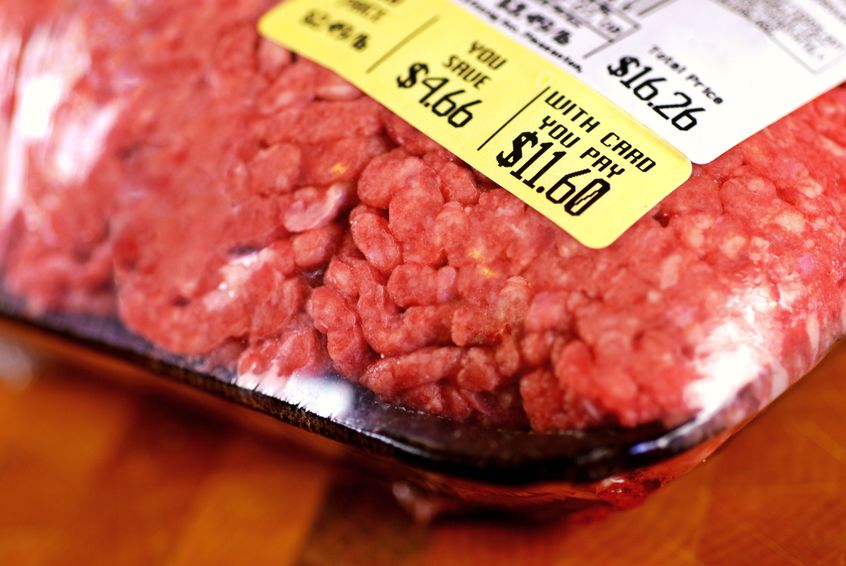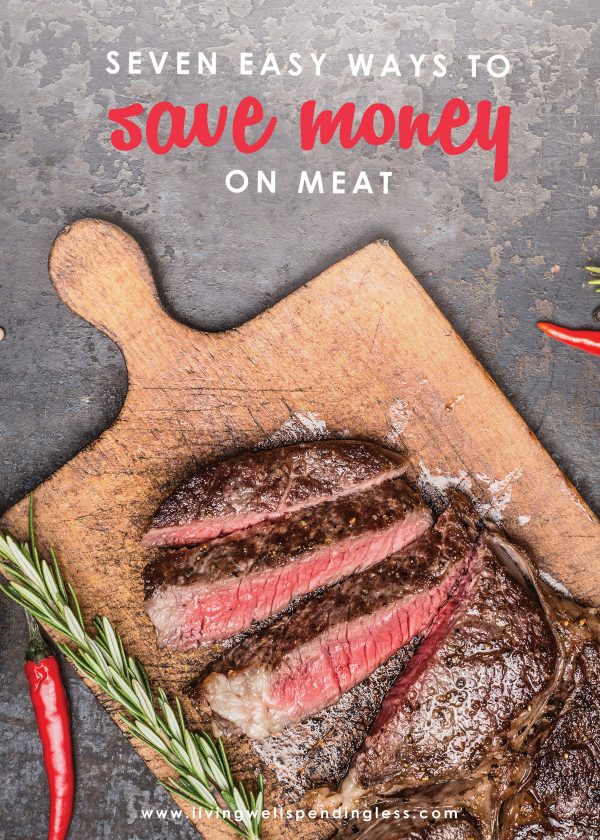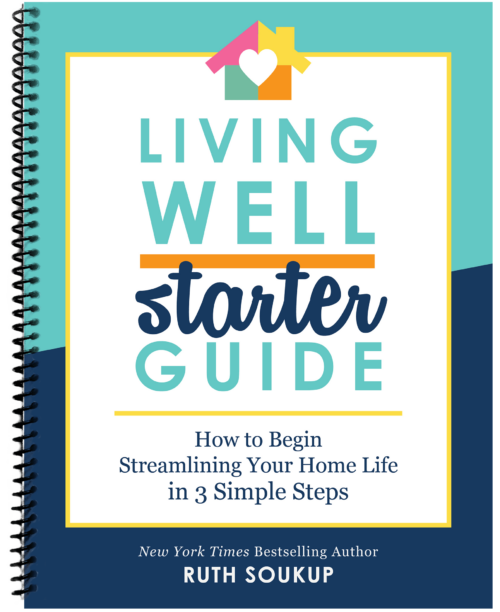This is a guest post from Kalyn Brooke of KalynBrooke.com
One of the major culprits of out-of-control grocery budgets is meat. It’s downright expensive, often overpriced, and yet we still continue to buy large quantities of it. Probably because men like my husband would throw an absolute fit if we didn’t!
The solution isn’t to get rid of meat all-together, but there are a few easy ways to help reduce the economic impact of this fridge and freezer staple. Practice all of these tips, and I guarantee you will see results within just a few weeks!
1. Eat Less Meat
It might seem a little obvious, but it’s true. Eating less meat will boost the bottom line, and give you an excuse to try new recipes outside chicken casseroles and sloppy-joes. Just implementing 2-3 meatless meals a week will reduce your need to buy it all the time, which will leave a little more wiggle room in your grocery budget. For fresh meal ideas, check out Ruth’s meatless meal section!

2. Know Your Price Per Pound
You can save a huge chunk of money just by knowing how much meat typically costs. Keep a grocery price book and write down the price per pound after every purchase. Pretty soon, you will start seeing a trend, and won’t need to reference your price book as often.
Bulk packages often have a lower price per pound, but are not always found in regular grocery stores. It might be worth it to consider paying for a membership at bulk food store, and see what they can offer. Don’t forget to record those prices in your price book too!
3. Freeze As Much As Possible
After each grocery store run, make it a habit to repackage all meat into smaller, plastic freezer bags as soon as possible. Then label, stack, and store in the freezer until it’s time to pull out for a lunch or dinner recipe.
Leaving meat in the fridge for more than a few days can cause it to spoil fast, and I would hate for you to waste all that money! Establish a rule that unless you will be using the meat that day, it goes straight into the freezer.
4. Don’t Buy Specialty Meat
It seems obvious that to save money on meat, you wouldn’t go out and buy a New York Strip Steak. Instead it’s more reasonable to stick to basic chicken breasts and ground beef.
However, you still have to watch what you’re buying. Boneless or thinly sliced chicken breasts cost much more than drumsticks or whole chickens, because you’re letting the butcher do all the work for you. I don’t know about you, but even though I hate touching raw meat, I’d much rather pay less and cut up the chicken myself!

5. Stretch the Life of Meat
I never pay much attention to meat portions in recipes, and if you’re trying to save money, you probably shouldn’t either. When the ingredients call for 4 chicken breasts, I use only two and cut them in half. I do the same with ground beef. A recipe might tell me to use whole pound, but I’ll use only half and just make the casserole less meaty. No one has ever noticed!
With a whole chicken, there is always a ton of meat left over. Freeze the extras for use in casseroles, and boil the bones for broth. I used to be so intimidated by this, but it is really easy! I still have jars of chicken broth in the freezer from months ago, and they are absolutely perfect for soups, stews, and to use with pasta dishes.
6. Buy a Portion of a Cow….or Pig
If you live in a farming area, definitely look into buying a whole animal or even half. This is best if you have a deep freezer to store it in, since I’m pretty sure they would never fit in my little kitchen one!
It might seem like a huge cost up front, but if you know your price per pound {point #2}, then it could potentially be a cheaper option in the long run.
7. Shop Unconventional Grocery Stores
Don’t be afraid to visit smaller international stores to see what their prices are on meat. We have found a gem of a store here in Southwest Florida that is mostly Hispanic, but has the best prices we’ve found on meat and produce.
Stores like Aldi or Save-A-Lot also have excellent prices on meat, not to mention a lower grocery bill all around for additional items. Shop around, compare prices, and plan your trips accordingly!
At first, it can seem impossible to lower your grocery budget any more than it already is, but once you start thinking of ways to scrimp and save, it becomes a little bit easier each time.
Avoid trying to save on everything all at once, and instead, focus on one portion of the grocery bill at a time. Take one month to focus on meat, one on produce, one on pantry items, and so on. By the time the year is over, you’ll be a pro at saving on everything!

Kalyn Brooke is a life management expert for busy women
who crave a simpler and more organized life. Through her recognizable, down-to-earth approach, she provides a daily dose of inspiration and guidance, whether you’re looking for smart money tips, time saving routines, or anything in-between. When she’s not experimenting with ways to do even the most mundane tasks more efficiently, you can find her crafting detailed to-do lists in her bullet journal, or indulging in—yet another—personal development book. Meet Kalyn and learn how stay on top of it all at KalynBrooke.com.
TAKE BACK CONTROL OF YOUR HOME LIFE
 Ever feel like you just can't keep up? Our Living Well Starter Guide will show you how to start streamlining your life in just 3 simple steps. It's a game changer--get it free for a limited time!
Ever feel like you just can't keep up? Our Living Well Starter Guide will show you how to start streamlining your life in just 3 simple steps. It's a game changer--get it free for a limited time!
If you love this resource, be sure to check out our digital library of helpful tools and resources for cleaning faster, taking control of your budget, organizing your schedule, and getting food on the table easier than ever before.











These are really good tips! We shop at Wegman’s a lot, and they do a “Reduced for Quick Sale” section for meats that are getting close to their “sell by” date. We get a ton of meat from that section — whatever we don’t use that day, we freeze. The prices are MUCH lower! Check to see if your grocery store has a similar section.
Another point for your readers is that as you get older (as in over 60 maybe?), you don’t eat as much. There are just 2 of us and we were throwing tons of food away every month simply because we fill up on much less. Well, maybe not tons but a lot. 🙂 Here is an example: one of our favorite recipes (h/t to my daughter-in-law) is Cheesy Chicken. When I originally started making it for us, I would use 2 boneless, skinless chicken half-breasts. One night after we finished, we looked at our plates and both of us had only eaten half of the half breast. We were throwing at least an entire one away. So, believe it or not, I bake one half-breast (boneless, skinless), use half of the soup called for and much less butter and cheese. Still our favorite! We are satisfied – not trying to diet on this one. 🙂 It is not low-cal, low-fat just so you know up front. Neither of us is much on leftovers so we have really started paying attention to how much we eat. For example, we buy a bit over a pound (only because it’s difficult to get “just” a pound) of 90% hamburger (you have to have some fat for flavor IMHO) and I separate into 3 portions, put in sandwich bags and then put the bags in a freezer bag, label. When we want something with hamburger, I just pull out one sandwich bag and on to the recipe. We have saved hundreds of dollars since we started paying attention to what we were eating and what we were throwing away.
Great idea!
Those are good tips. I keep a price book too. What I do, is to have a different protein source every day so our week looks like this: beef, chicken, albacore tuna, black beans, eggs and then two days a week I repeat one of those. More often than not, I only purchase one item of beef per week and one item of skinless boneless chicken breasts per week. I only purchase organic protein sources so it is more expensive but since toxins are stored in fat, if you are going to go organic on anything, make it your protein sources. I realize it’s a bit more expensive to purchase organic beef or organic chicken but I only buy one of them per week. One pound of organic chopped sirloin runs $7.50/pound and a pound of organic chicken runs the same. By using them only once a week, I save money and we get some variety. If I am making something like spaghetti and meatballs, I’ll use a slice of homemade bread to make breadcrumbs to stretch it a bit. I spend around $100 a week for two people but my son is disabled so I buy a lot of fruits and vegetables since I make everything from scratch and he eats a blenderized diet of real food (lots of organic) via a feeding tube to keep him healthy.
Dream Mom … YOU are an inspiration!
I’ve been reducing the amount of meat in recipes for awhile. It really does help and isn’t noticeable in casseroles, or dishes mixed with pasta/rice. One thing that helps me is to shop loss leaders. I noticed years ago that my local grocery stores usually have chicken, ground beef, and cheaper roast/steak on sale the 2nd or 3rd week of each month. I try to stock up for the entire next month when I see the sales. Also, knowing seasons/holidays helps. For example, around Easter ham will go on sale. So buy several, cut them up in meal-sized portions and freeze them for coming months. Thanks for reminding me of these great tips!
Nice additional info about buying & saving on meat. I LOVE your website and the extra goodies you add. Keep up the great work!